M
I
C
R
O
S
T
O
R
Y
O
F
A
R
T
........................................................

NOW COMPLETED:

........................................................
MICROSTORY OF ART
ONLINE JOURNAL FOR ART, CONNOISSEURSHIP
AND CULTURAL JOURNALISM
........................................................
INDEX | PINBOARD | MICROSTORIES |
FEATURES | SPECIAL EDITIONS |
HISTORY AND THEORY OF ATTRIBUTION |
ETHNOGRAPHY OF CONNOISSEURSHIP |
SEARCH

........................................................



 >MICROSTORIES
>MICROSTORIES
- Richard Serra
- Martin Scorsese
- Claude Simon
- Sunshine
- Werner Herzog
- The Creation
- Marcel Duchamp
- Nino Rota
- Wölfflin and Woolf
- Hansjörg Schneider
- Kraftort Arkadien
- Visual Biography
- Schlaraffenleben
- Die Geisteswissenschaften
- The Voyeur
- Buzzword Sustainability
- Paul Verlaine
- Tao Yuanming
- New Beginning
- Seneca
- Still Lifes
- Charles Baudelaire
- Frédéric Chopin
- The Art History of Sustainability
- Wang Wei
- Solarpunk
- Historians of Light
- Lepanto
- Renaturalization
- Plates
- Snow in Provence
- Learning to See
- Picasso Dictionaries
- Peach Blossom Spring
- Picasso Tourism
- Tipping Points
- Sviatoslav Richter
- Weather Reports
- Treasure Hunt
- Another Snowscape in Picasso
- Picasso in 2023
- Dragon Veins
- The Gloomy Day
- The Art of the Pentimento
- Reforestation
- The Status of Painting
- Emergency Supply
- Punctuality
- Watching Traffic
- Zhong Kui
- How Painting Survived the 1990s
- Confirmation Bias
- Sustainability and Luxury
- Garage Bands
- Picasso and Artificial Intelligence
- Eyes of Tomorrow
- Picasso in 2023 2
- Gluing Oneself to Something
- Suburbia
- Bamboo
- Sustainability and Carpe Diem 1
- Interviews with Bruegel
- Sustainability and Carpe Diem 2
- Coffee & Sugar
- Bamboo 2
- Picasso in 2023 3
- Sustainability and Carpe Diem 3
- Cherry Orchard
- Old Magazines
- Chance
- Nick Drake
- Harlequin
- The Smartphone & the Art Book
- Atlas Syndrome
- The Kitchen
- Atlas Syndrome 2
- Consideration
- Tori Amos
- School
- Orchard Auctioning Day
- The Hundred Years’ War
- Sócrates
- Chameleon
- Nefertiti Bust
- Picasso as a Computer
- Sunflowers
- Philemon & Baucis
- Ode to the Radio
- Childhood
- Wimmelbild
- Restitution
- Nick Drake 2
- Wishful Thinking
- Sundays
- The Independent Scholar
- September
- The Fisherman by Pirosmani
- Microadventure
- Sociology
- Salvator Mundi
- Chillon
- Appassionata
- Amber
- Homer
- Berlin
- Planet Walk
- Improvisation
- Seeing Picasso
- These Nice Kids
- Robber
- The One
- The Sea Turtle
- Zoo
- Through the Hush
- Wunderkammer
- I Do Not Seek, I Find
- Shopping Mall
- Food Hamper
- The Secretary
- This Gate
- Nor Rainy Day
- House on a Hill
- Beautiful Island
- Second-hand Bookstore
- Flat
- Slap in the Face
- Serra, Wenkenpark
- Apologies
- The Bells
- Nordmann Fir
- Picasso Wanting To Be Poor
- Picasso, Pirosmani
- A Brief History of Sculpture
- 24 Sunsets
- Rusty Phoenix
- Glove
- Wintry Stanza
- A Song
- Like A Beatle
- Catching An Orange
- Solar Bees
- Permaculture

 >FEATURES
>FEATURES
- Van Gogh On Connoisseurship
- Two Museum’s Men
- Ende Pintrix and the City in Flames
- Titian, Leonardo and the Blue Hour
- The Man with the Golden Helmet: a documentation
- Un Jury d’admission à l’expertise
- Learning to See in Hitler’s Munich
- Leonardo da Vinci and Switzerland
- The Blue Hour Continued
- The Blue Hour in Louis Malle
- Kafka in the Blue Hour
- Blue Matisse
- Blue Hours of Hamburg and LA
- A Brief History of the Cranberry
- The Other Liberale in the House
- The Blue Hour in Raphael
- Who Did Invent the Blue Hour?
- Monet on Sustainability
- Velázquez and Sustainability
- The Blue Hour in Guillaume Apollinaire
- Van Gogh on Sustainability
- The Blue Hour in Marcel Proust
- Picasso and Sustainability
- The Contemporary Blue Hour
- The Blue Hour in 1492
- The Blue Hour in Hopper and Rothko
- Hopper and Sustainability
- The Blue Hour in Ecotopia
- The Hour Blue in Joan Mitchell
- Explaining the Twilight
- The Twilight of Thaw
- The Blue Hour in Pierre Bonnard
- Explaining the Twilight 2
- Picasso on Stalin
- Rubens on Sustainability
- The Salvator Mundi in Bruegel and Rubens
- The Blue Hour in Leonardo da Vinci and Poussin
- The Blue Hour in Rimbaud
- Faking the Dawn
- Frost and Thaw in Ilya Ehrenburg
- Picasso, Stalin, Beria
- Picasso, Solzhenitsyn and the Gulag
- Shostakovich on Picasso
- Hélène Parmelin in 1956
- Historians of Picasso Blue
- Picasso Travelling to Moscow 1
- The Blue Hour in Caravaggio
- Picasso Travelling to Moscow 2
- Picasso, the Knife Game and the Unsettling in Art
- Some Notes on Leonardo da Vinci and Slavery
- Picasso Moving to the Swiss Goldcoast
- The Blue Hour in Camus
- The Blue Hour in Symbolism and Surrealism
- Caspar David Friedrich in His Element
- Exhibiting the Northern Light
- Caspar David Friedrich in His Element 2
- Robert Schumann and the History of the Nocturne
- The Blue Hour in Robert Schumann
- Caspar David Friedrich and Sustainability
- The Twilight of Thaw 2
- Multicultural Twilight
- The Blue Hour in Anton Chekhov
- The Blue Hour in Medieval Art
- Twilight Photography
- The Blue Hour in Bob Dylan
- Iconography of Optimism

 >SPECIAL EDITIONS
>SPECIAL EDITIONS
- Visions of Cosmopolis
- Mona Lisa Landscapes
- Turner and Ruskin at Rheinfelden
- Painters On TV & On TV
- Spazzacamini in Art
- A Last Glance at Le Jardin de Daubigny
- The Experimental Cicerone
- A Dictionary of Imaginary Art Historical Works
- Iconography of Blogging
- Begegnung auf dem Münsterplatz
- Cecom
- Das Projekt Visual Apprenticeship
- Those Who See More
- A Fox on Seeing with the Heart
- Sammlung Werner Weisbach
- Daubigny Revisited
- Some Salvator Mundi Microstories
- Some Salvator Mundi Afterthougths
- Some Salvator Mundi Variations
- Some Salvator Mundi Revisions
- A Salvator Mundi Questionnaire
- A Salvator Mundi Puzzle
- Unknown Melzi
- Francis I and the Crown of Charlemagne
- From Amboise to Fontainebleau
- Drones Above Chambord
- Looking Back At Conques
- Flaubert At Fontainebleau
- Images of Imperial Ideology
- The Chronicles of Santa Maria delle Grazie
- Seeing Right Through Someone
- Melzi the Secretary
- Eying Glass
- A Foil to the Mona Lisa
- A Renaissance of the Cartoon
- Sketching a Family Tree
- Venetian Variations
- A Brief History of Digital Restoring
- A Consortium of Painters
- Leonardeschi and Landscape
- A Christ in Profile
- Learning to See in Spanish Milan
- A History of Gestures
- Leonardo and Josquin
- A Renaissance of the Hybrid
- Suida and Heydenreich
- The Watershed
- Three Veils
- From Beginning to End
- Connoisseurship of AI
- Twilight and Enlightenment
- The Blue Hour in Chinese Painting
- Dusk and Dawn at La Californie
- Iconography of Sustainability
- The Blue Hour in Goethe and Stendhal
- The Sky in Verlaine
- The Blue Hour in Paul Klee
- Iconography of Sustainability 2
- The Blue Hour in Charles Baudelaire
- From Bruegel to Solarpunk
- Some Salvator Mundi Documentaries
- Some More Salvator Mundi Monkey Business
- The Windsor Sleeve
- Brigitte Bardot’s Encounter with Picasso
- Art Historians and Historians
- A Salvator Mundi Chronicle
- The Salvator Mundi and the French Revolution
- The Fontainebleau Group
- The Encounter of Harry Truman with Pablo Picasso
- The Fontainebleau Group Continued
- The Windsor Sleeve Continued
- The Salvator Mundi in Early Netherlandish Painting 1
- Some Salvator Mundi Resources
- A New Salvator Mundi Questionnaire
- The Woman in Picasso
- The Yarborough Group
- Melzi, Figino and the Mona Lisa
- The Yarborough Group Continued
- A Salvator Mundi Global History
- The Salvator Mundi in Medieval Art
- The Salvator Mundi in Medieval Art 2
- The Salvator Mundi in Early Netherlandish Painting 2


 >HISTORY AND THEORY OF ATTRIBUTION
>HISTORY AND THEORY OF ATTRIBUTION
- The Mysterious »Donna Laura Minghetti-Leonardo«
- Assorted Demons of Connoisseurship
- Panofsky Meets Morelli
- Discovering the Eye of Sherlock Holmes
- Handling the Left-handed Hatchings Argument
- Visual History of Connoisseurship
- Alexander Perrig
- Connoisseurship in 2666
- What Postmodernity Has Done to Connoisseurship
- Dividing Four Fab Hands
- A Leonardesque Ambassador
- Test Cases in Connoisseurship
- A Raphael Expertise
- How to Tell Titian from Giorgione
- Louise Richter
- The Unique Property in the History of Connoisseurship
- An Expertise by Berenson
- The Book of Expertises
- An Album of Expertises
- An Expertise by Friedländer
- A Salvator Mundi Provenance
- How to Tell Leonardo from Luini
- An Expertise by Crowe and Cavalcaselle
- An Expertise by Bayersdorfer
- An Expertise by Hermann Voss
- An Expertise by Hofstede de Groot
- Leonardeschi Gold Rush
- An Unknown »Vermeer«
- An Expertise by Roberto Longhi
- An Expertise by Federico Zeri
- A Salvator Mundi Geography
- A Salvator Mundi Atlas
- The Bias of Superficiality
- 32 Ways of Looking at a Puzzle
- James Cahill versus Zhang Daqian
- Five Fallacies in Attribution
- On Why Art History Cannot Be Outsourced to Art Dealers
- On Why Artificial Intelligence Has No Place in Connoisseurship
- Salvator Mundi Scholarship in 2016
- Leonardo da Vinci at the Courts
- The Story of the Lost Axe
- The Last Bruegel
- A Titian Questionnaire
- On Where and Why the Salvator Mundi Authentication Did Fail
- The Problem of Deattribution

 >ETHNOGRAPHY OF CONNOISSEURSHIP
>ETHNOGRAPHY OF CONNOISSEURSHIP
MICROSTORY OF ART
ONLINE JOURNAL FOR ART, CONNOISSEURSHIP
AND CULTURAL JOURNALISM
........................................................

***
ARCHIVE AND FURTHER PROJECTS

1) PRINT


***
2) E-PRODUCTIONS


........................................................

........................................................

........................................................
FORTHCOMING:


***
3) VARIA

........................................................

........................................................

........................................................

........................................................

........................................................
***
THE GIOVANNI MORELLI MONOGRAPH

- The Giovanni Morelli Monograph
........................................................
MICROSTORY OF ART
ONLINE JOURNAL FOR ART, CONNOISSEURSHIP AND CULTURAL JOURNALISM
HOME
MICROSTORY OF ART ONLINE JOURNAL FOR ART, CONNOISSEURSHIP AND CULTURAL JOURNALISM Francis I and the Crown of Charlemagne |
See also:
Some Salvator Mundi Microstories
Some Salvator Mundi Afterthoughts
Some Salvator Mundi Variations
How To Tell Leonardo From Luini
Francis I and the Crown of Charlemage

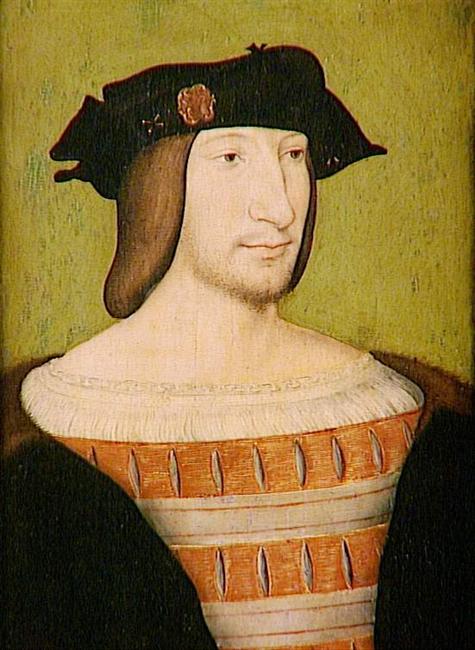
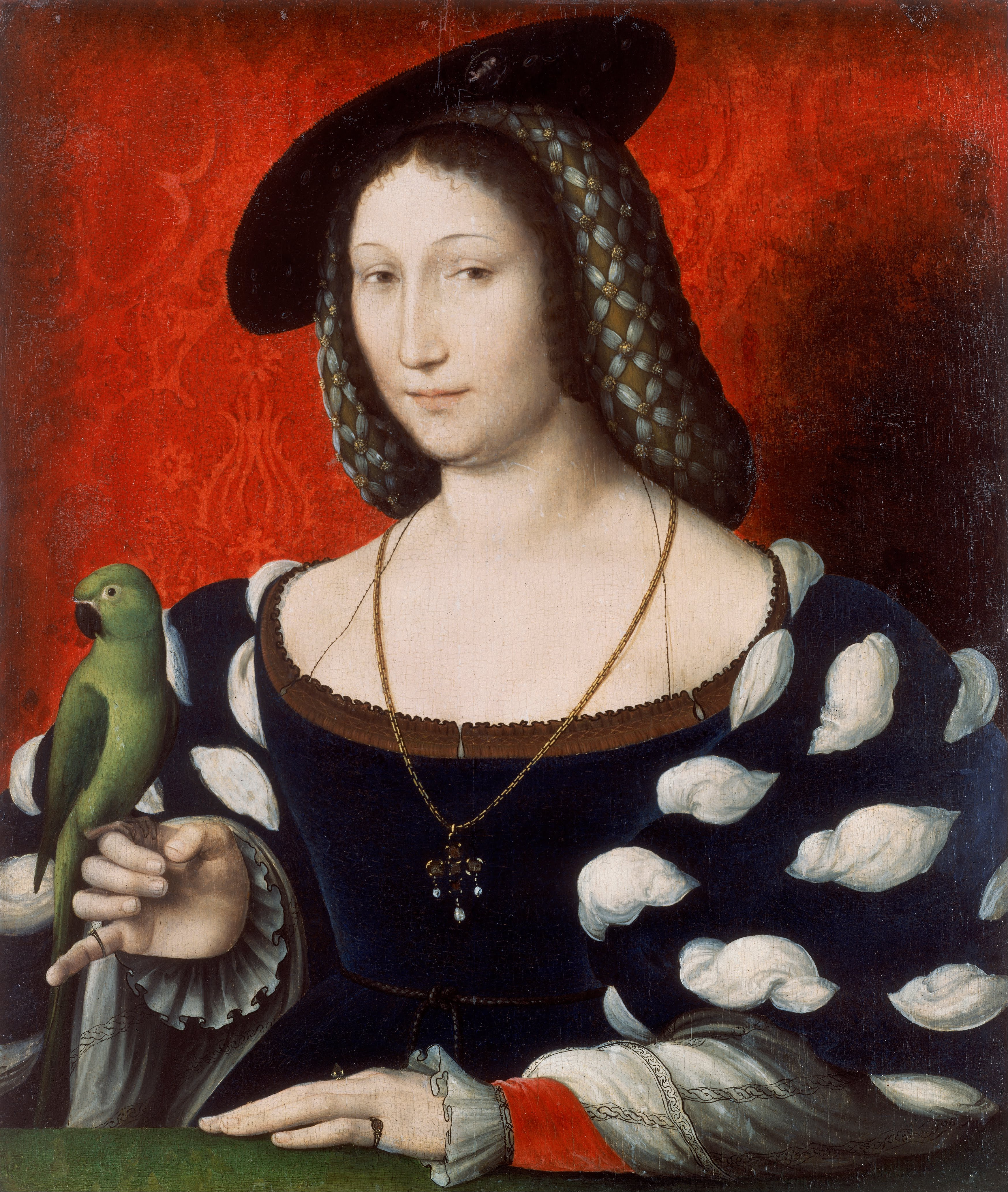
(15.6.-17.6.2021) Here we are completing a trilogy. With my Salvator Mundi Puzzle we had begun to investigate
the intertwinings of the cult of Charlemagne with the history of Salvator Mundi paintings.
We had developed a plausible hypothetical reconstruction of the specific biography of one of its most prominant examples:
the version Cook. A biography, compatible with the findings of technical art history, with general history
and with stylistic observations in the version Cook (with its various levels of technical accomplishment).
Its biography, I’d like to remind that in particular, is supposed to be a biography embedded into a history
of all the other versions, but we had limited our task to giving only the essential minimum to herald what I am
calling a New Salvator Mundi History.
With my contribution on Francesco Melzi, supposed main author of the version Cook, we had further investigated
and explained what we should be calling the ›Melzi problem‹ of Leonardo-scholarship (please do not repeat the
empty phrase ›only Leonardo could have painted that‹, until we have a reliable Melzi oeuvre catalogue, which,
by the way, would be the same thing as a reliable Leonardo oeuvre catalogue: you simply cannot know if ›only
Leonardo could have painted this – or that‹, as long as Melzi is as unknown as he is…). If I am right in placing
the genesis of the version Cook into Leonardo da Vinci’s last period, his stay in France, we have to work with
whoever is there: Leonardo, Melzi and Salaì in the main place (Boltraffio had died in 1516, and Luini or Giampietrino
simply are not there), but we also have to be familar with Franco-Flemish court artists, Italian humanists,
with one (Italian-born) specialist for Charlemagne in particular, and with the king who was pleased to be the
patron of all these figures: French king Francis I, with his mother, Louise of Savoy, and his sister, Marguerite of
Navarre, on his side. And this is what we are going to do here, in my third contribution heralding a New Salvator Mundi
History: we are going to further eludicate the social space in which I have placed the genesis of our version Cook.
And this means here in very particular: the iconographical context in which any biography of the notorious version Cook
has to be placed. We are going back to the intertwinings of the cult of Charlemagne and the history of Salvator Mundi
paintings, we are going to comtemplate some crowns, and I hope it is going to be a feast for fans of iconography. If it
is going to be a feast for proponents of the hypothesis that version Cook is a completely autograph picture
by Leonardo – and this is what it is: nothing more than a hypothesis, not fact, a hypothesis only rivalling our
alternative hypothesis – if it thus is going to be a feast for these proponents, I don’t know. Maybe we should listen
a bit more careful to what Louise of Savoy has to say in 1519.



One) Preliminary Remarks
1.1 As to the role of hypotheses
It was Christopher Columbus’ hypothesis that by sailing westward one could reach Asia. Reaching a shore he found
his initial hypothesis seemingly confirmed, but he sailed on, realizing that what he had found were merely
islands and not the mainland of Asia. On a later voyage, on the island of Cuba, he had his men swear – and it was
Stephen Greenblatt to highlight this particular episode – that they had reached China. And this of course, is exactly
what scholarship should be warned of: a) the premature declaring of truths (since posterity knows that Columbus
was wrong in a double way: neither had he reached, with Cuba, the mainland that he sought, nor was it the continent
of Asia); and b) any ritualistic affirming of alleged truths, which, speaking in modern terms, is nothing but
a symptom that the stage of ideology has been reached, the closing of the mind for possible revisions of initial
hypotheses and a (possibly deliberate) blindness for everything, observations and experiences, that potentially could
contribute to challenging and revising an initial hypothesis that, still, had helped to bring Columbus to where he was:
to Cuba.
The ideal explorer (if this is the right word) would have sailed around Cuba, to find out if this was the mainland or
another island. And this should be our guiding metaphor: sailing around the island of Cuba. Since this is what
scholarship has to do: finding hypotheses, our tools of the mind, testing them, develop plausible narratives based on
them and thus explaining and understanding social space.
And scholarship should also be, at least in my view, very reluctant in declaring findings to be truths, even if,
or especially because this is what the public is waiting for. We should raise questions and answer them as good as we
can, and then step back behind our work. What we should not do is to step before a microphone at a stage that
hypotheses have not been sufficiently tested and still declare our findings to be the truths. Perhaps we should even
be a little bit more reluctant in using the big word ›truth‹ itself. And instead we might say that we are seeking
to produce something that will stand the test of time (and the test by other scholars). This is as close as we can
get to the truth. And everything I am saying here is of course indirectly pointed to the stage the Salvator Mundi debate
has reached. In my eyes it is a stage of empty phrases repeated again and again. And this is the moment we have
to recall that what we have to do is to sail around Cuba. And this is exactly what I am trying to do here: to further
explore (because there still are, contrary to what the so-called leading scholars might say or suggest, countless islands
to explore). And as I said I am aware that the public tends to await truths from scholarship, and in a certain sense
the public should. But on the other hand the public has also to understand that scholarship is the process of constant
revising, and I think it is enough (in order to challenge the standard narrative of Salvator Mundi research) to show
that a plausible alternative model can be formulated. And this, in brief, is what our trilogy is meant for (a list of
reasons why I think that my model is plausible will be given in a synopsis below).
1.2 As to iconography and terminology
Modern iconography is more or less a grid. The types and categories modern iconography is offering should not be
confused with the ways contemporaries in the late Middle Ages and the Renaissance saw and interpreted things.
The order we may find is not the or the only nature of things; it is the order we have constructed in retrospect,
and we have to work with iconographic types, but should remain aware that these types are our contructions
and not found in ›nature‹ (which means here: in the history of art, in which individual examples are found
and also tendencies, but not types). In the history of art we find phenomena that more or less will match our ideas
and more or less will work as our constructions would like them to work. But the reality we find, and we will see
examples below, is more ambivalent than we might expect.
The iconographic grid that I will using here starts with the iconographic type called Christ in Majesty (a frontally represented
enthroned Christ who is usually holding the book of life in his left hand, and at the same time is,
due to a gesture of his right hand, also a blessing Christ. If Christ holds an orb in his left hand instead of
the book of life, I will speak of a Salvator Mundi instead (one might say, in retrospect, that a Christ in Majesty
has turned into a Salvator Mundi, but this is exactly the way of looking at things in a modern way).
From Christ in Majesty and Salvator Mundi type subtypes can be derived: Christ Pantocrator (a half-length representation
of Christ, blessing and holding the book of life), and the half-length Salvator Mundi type we are perhaps already
all-too-familiar with. Because we should stay aware, that what we might see: perhaps a devotial picture with Christ
as the Saviour blessing the world, as we will see below, is not necessarily exactly what a king or a queen
might have seen at around 1520. (second picture above from the left: Jean Colomb)

Two) The Cult of Charlemagne
In the beginning was the cult of Charlemagne. In the beginning of what? In the beginning of the trend in late
medieval and Renaissance art to depict Christ holding an orb. Martin Kemp has pointed to the intertwining of
these two traditions (as one may call it also) in 2019 and in rather general terms (see Dalivalle/Kemp/Simon 2019,
p. 72): «The sphere of the Salvator Mundi compositions had been adopted widely across cultures to manifest a ruler’s
command over the world and had become closely associated with Christian imagery following Charlemagne’s adoption
of the orb (topped by a cross) and sceptre.« In other words: first there was Charlemagne’s adoption of the orb,
then Christian imagery followed – one has to recall Charlemagne’s canonization in 1165 – and then we have also
depictions of Christ holding an orb (or globus cruciger). The natural reason for this close association of two
traditions – we have to point that out here more clearly – was the idea of the Divine right of kings: they rule
by the divine right, ›by Christ‹: their wordly mandate and power is handed over to them by Christ, and as rulers
they act (ideally – but it is about ideas here) as advocats of Christianity as well as of the church (the emperor
of the Holy Roman Empire, for example, is also seen as advocatus ecclesiae). What Christ and what a ruler is
holding, if both are holding an orb, is not necessarily to be interpreted as the same specific thing (even if it is
always a command over a world), but it can – depending of contexts – become the very specific same thing: for example
the command over the Holy Roman Empire, the ideally universal Christian monarchy over (potentially) the whole world.
What Martin Kemp has alluded to in most general terms we have found specifically confirmed as to the Salvator Mundi
version Cook: the depiction of Charlemagne holding a crystal orb in the Crucifixion of the Parlement of Paris
(painted in around 1452) has been followed – over half a century later – by our notorious depiction of Christ holding
a crystal orb, and in both cases the crystal orb replacing the traditional globus cruciger could (rightly or wrong) be
interpreted as a rendering of rock crystal. What we are doing here is simply to explore the social space around these
two works of art more specifically.
The standard narrative of Salvator Mundi thinking gives a rather early date to the Leonardesque painting. It is rather
obvious that one does want an early date, so that all the other version can be regarded as copies. But I have shown
that there is arbitrariness in this model: if we assume that a Salvator Mundi cartoon existed (early; namely probably
already at the time Leonardo da Vinci was working in Santa Maria delle Grazie), then this cartoon was the reference
of all the versions. The thumb pentimento in the version Cook – interpreted as manifesting an artist’s change of mind
by those who want the painting to be an autograph painting – can also be interpreted as a correction bringing back
the thumb to the position where it had meant to be (as in the cartoon). Nobody has ever explained why we should accept
the standard model as a dogma. In fact: the alternative we have been proposing for a while, has simply been ignored.
But the probblem of two equally plausible alternatives does not disappear if is ignored. On the contrary: if alternatives
exist, it is the task of scholarship to further explore the social space of the alternatives, and this is what we are
doing here. And we have to return to the kings at this point.
The Crucifixion of the Parlement of Paris had been painted for the French king Charles VII (the one supported
by Joan of Arc) and at the time the Hundred Years War came to an end. The French monarchy, as historians know,
at the end of this secular war came out, compared to the aristocratic elites, rather strengthened (also the institution
of the Parlement was renewed at the time of Charles VII), and in the wake of this secular war the French monarchy
consolidated its power. Step by step, until one ruler, Francis I, could even aspire to the crown of the Holy Roman
Empire in 1519, in other words: to the crown of Charlemagne.
Francis I, who by the way personally supported the humanist and historian Paolo Emilio, a member of his court, in his
writing of a history of the Franks, had already been, as the French king, crowned with the (French) crown of
Charlemagne, but the crown of the Holy Roman Empire was also seen as the crown of Charlemagne and the one who would
follow emperor Maximilian I (who died in January 1519) would be Charlemagne’s successor (picture of the imperial crown above:
C. Löser; shown above on the left is the French crown).
The notorious Salvator Mundi version Cook, the picture ›having been in the possession of three kings‹ – had it been
painted for the French king Louis XII, as also has been proposed, or for Francis I (or for his mother Louise of Savoy
respectively)? Are we entitled to speculate since we have nothing to work with, or do we have something to work with?
And I think, with the intertwining of the two traditions, the cult of Charlemagne on the one hand and the
iconographical trend to depict Christ holding an orb on the other, we have something to work with. Since we can
think about a) the intensity of interactions Leonardo da Vinci might have had with several French kings and b)
about the question which ruler identified the most with Charlemagne and would have been the most inclined to have a
Salvator Mundi painting interact – iconographically – with a depiction of Charlemagne at the heart of French politics:
the Parlement.
I think it is rather obvious – with Raphael’s depiction of Francis I as Charlemagne holding on orb in the Vatican,
where Francis had found, in pope Leo X., an ally, also for his aspiration to become ruler of the Holy Roman Empire –
that Francis I was the French king who most extremely identified with Charlemagne and strived to become his successor
on the European level. And even if the Leonardo legend might have exaggerated the intensity of the relationship between
Leonardo and the French king – the intensity of Leonardo’s interactions with the French monarchy was obviously the most
high at the time of Francis I, even if we concede that there were also contacts at the time of Louis XII and with
court painter Jean Perréal for example; but have we ever thought about the possibility that for example the Salvator
Mundi version Ganay, with its traditional globus cruciger that does not seem to interact with the Paris depiction of
Charlemagne holding a crystal ball – might have been an earlier version, possibly painted for French patrons? The
standard model of Salvator Mundi thinking does exclude this possibility, but I think it is rather likely that Ganay was
an earlier version produced after the aforementioned cartoon, while the step from globus cruciger to crystal ball
happened in interaction with the French monarchy who did want an interaction on the level of iconography with a
specific depiction of Charlemagne, being specifically important for the French monarchy. In other words: it seems more
plausible to me that the Salvator Mundi version Cook was produced (or finished) in France at the time of Francis I
who was the most ardent admirer of Charlemagne, aspiring for his crown as the ruler of the Holy Roman Empire in 1519.
All we have to give up is the Salvator Mundi ideology of ›one original and all the other versions are copies‹
replacing it with the model of ›one cartoon as the reference of all the version‹. And we have to dismiss the ideology
of the thumb pentimento ›manifesting a change of mind of Leonardo da Vinci‹, replacing it with the interpretation
of the pentimento as ›one correction was needed to bring back the thumb to the position it had originally meant to be‹.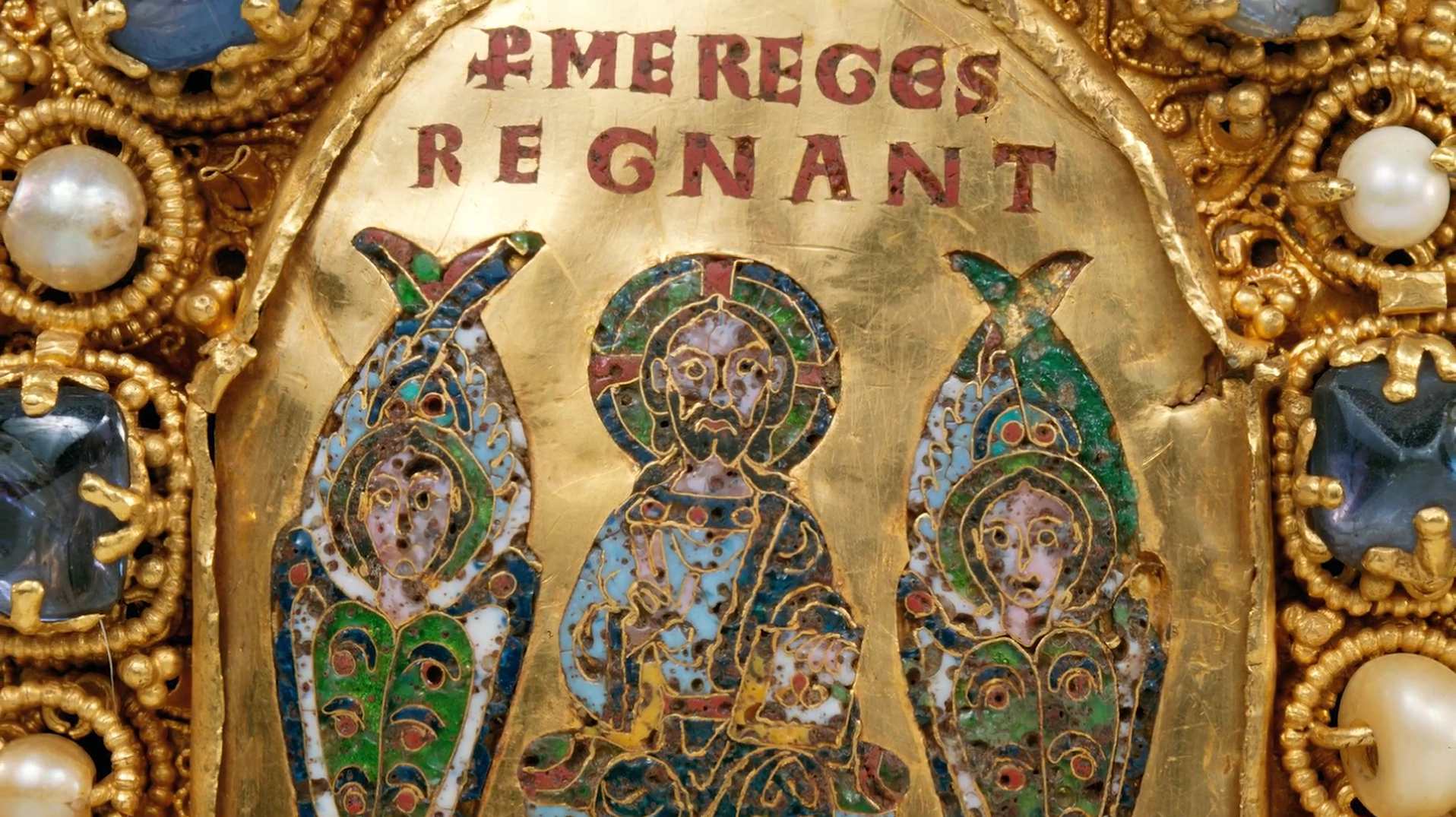

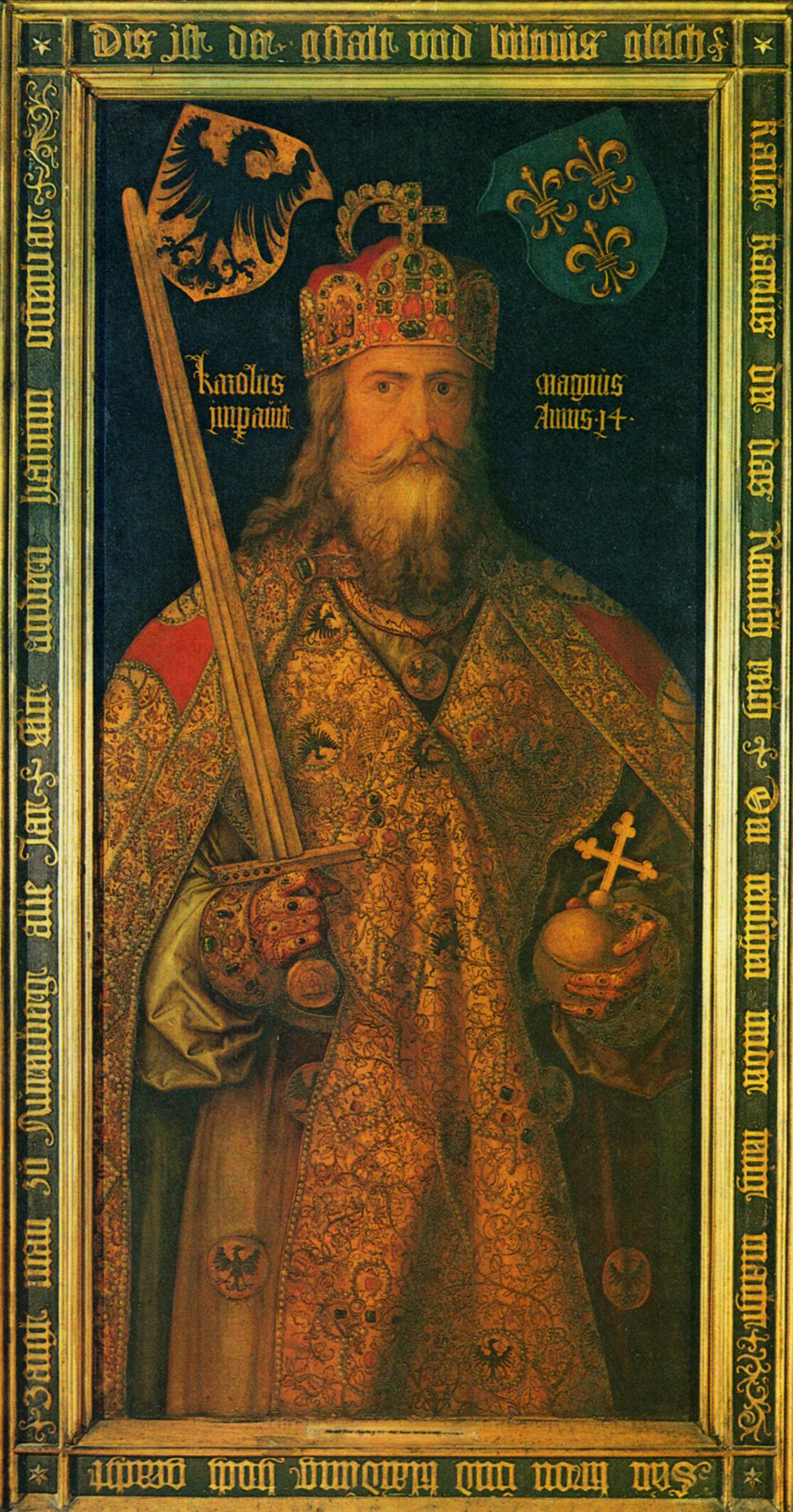
Three) The Crown of Charlemagne or: An Unknown Salvator Mundi by Albrecht Dürer
During the Middle Ages and the Renaissance the crown of the Holy Roman Empire could be seen by those people
present at the few occasions it was shown publicly. But certainly only very few people could ever see the crown
from that close as Albrecht Dürer could around 1510. One has to know that, on the one hand, the crown,
along with the other imperial insignia, was being kept at Nuremberg at the time, and that, on the other hand,
Dürer had been commissioned to paint idealized portraits of Charlemagne and of the emperor Sigismund. He did
the drawing of the crown shown here (also in the title of this contribution) probably in around 1510; the portraits
were produced somewhat later by him and his workshop.
Only the portrait of Charlemagne does concern us here (the original being at Nuremberg, while the Vienna Schatzkammer,
along with the insignia, is displaying today a later copy), and of course the portrait itself can be seen as a
more or less imaginary portrait of Charlemagne. But the depiction of the imperial crown was rather accurate –
except that Dürer, as can be seen well in the drawing, interpreted the Christ in Majesty on the Christ in Majesty plate
as a Salvator Mundi, obviously interpreting the structure of the enamel as a rendering of a globus cruciger
and not as a book of life. This Salvator Mundi, although or just because Dürer left an unfinished Salvator Mundi painting
(today in the Metropolitan Museum of Art, and although his ›other‹ one figured at a place that could not be
more symbolical, seems to be completely unknown, which I find rather remarkable. It is there in front of our eyes,
and we seem not be able to see it, partly due to pictures, of course, that do not show us the details properly;
and I have found only a detailed picture of the crown in the Vienna version that I can show here (picture below);
it is taken from a documentary by Waldemar Januszczak dealing with the Dark Ages, a film that can be found on Youtube;
for the detail of the Christ in Majesty plate with the Latin inscription above see also youtube.com (for this picture
the source is: 100 Meisterwerke by KMW).
We should be focussing here on the sensuous aspect of a medieval object as central as the imperial crown is,
as well as on the intellectual aspect. It is not relevant here if Dürer’s reinterpretation of the
Christ in Majesty plate had any real impact and, for example, shaped the idea people had of the crown
(we don’t know for example if the French king Francis I had a precise idea of how the crown looked like
that he strived for). What is relevant is that Dürer teaches us here, without him wanting to, that a Salvator Mundi,
a Blessing Christ holding a globus cruciger, goes perfectly together with the political theology displayed by the
inscription on the plate. The Latin phrase ›Per me reges regnant‹ is drawn from the Old Testament, but shown with a
Christ, and expresses the idea of the Divine Right of the Kings. ›By me (Christ) the rulers are ruling‹ – the Holy Roman
Empire obviously, but in fact any Christian realm as well. And this idea, naturally, was as all-known as the crown
was all-known, while the specific pictorial details on the crown could be seen by only very few people.
And the point is, and this is the main reason for this Dürer excursus, that Dürer’s reinterpretation of the plate
makes something graspable for us, something which is not as obvious as it might have been for a Renaissance artist:
Christ holding an orb is also a Christ holding the Holy Roman Empire in his hands, which, occasionally, is handed over
by Christ to an elected ruler who, by this act is legitimized by Christ, and, one might add, ›responds‹ to Christ
and has to legitimize himself by his acts before Christ. Brief: this is the political aspect that a Salvator Mundi
depiction potentially could have, if it is bearing an inscription or not. We modern people would need the inscription –
the contemporaries of Dürer would not have needed it. And certainly the kings – if it was a picture owned by kings –
would not have needed it at all.
The sensuous aspect of the crown, to come also to that, and of Dürer’s depiction of it, is as fascinating as the merely
intellectual aspect, since the globus cruciger figures, in Dürer’s depiction, as a jewel or pearl among other jewels and pearls.
And this is not very far – actually this is only one tiny step away – from replacing the more traditional globus cruciger
with a crystalline ball, another jewel (that might or might not be read as a representation of rock crystal).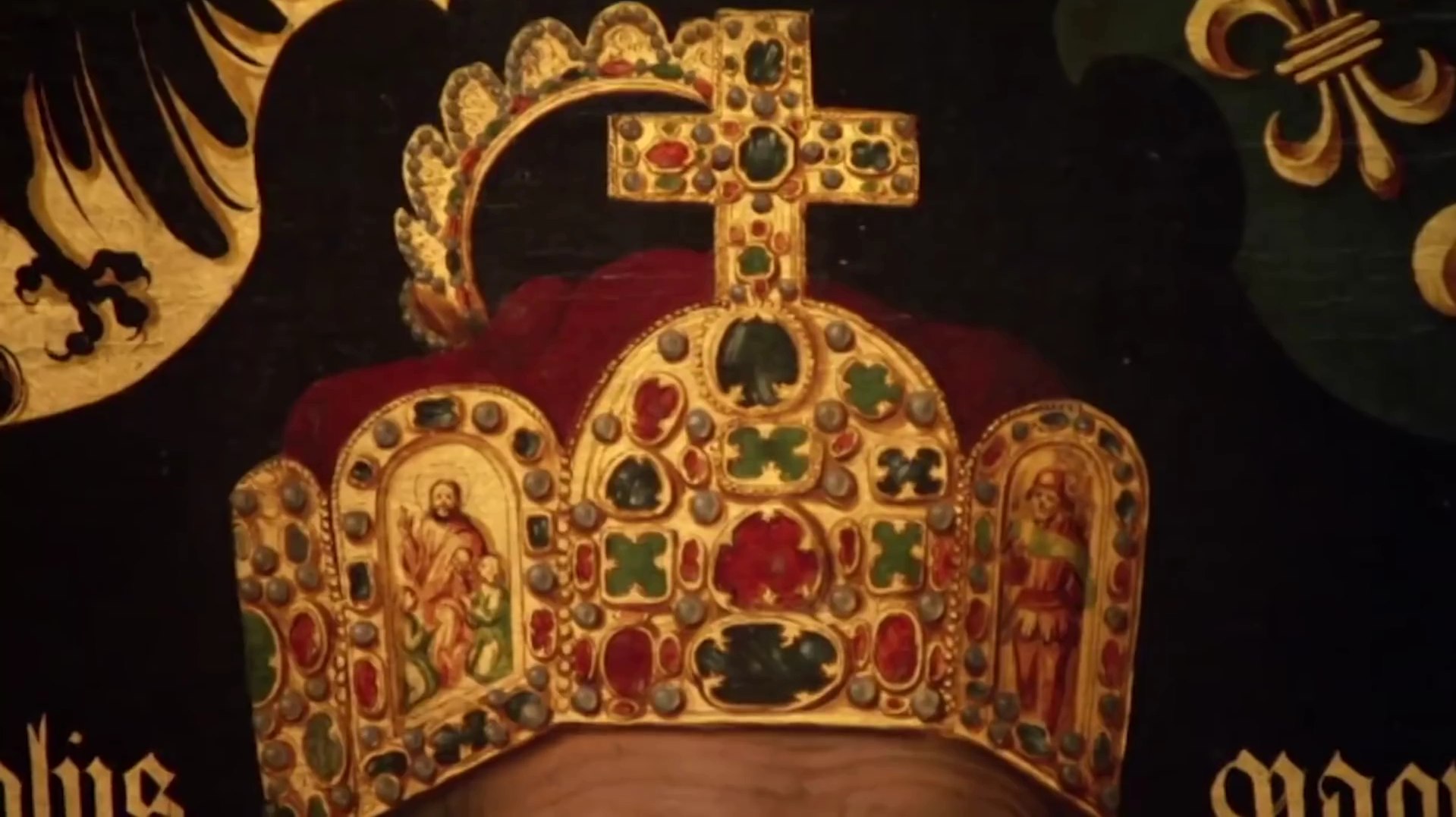
Four) Private Devotion or Political Theology? Further elucidating the context
When French king Francis I heard, in early July 1519, that his Hapsburg rival Charles had been elected German king
in Francfort and thus proclaimed emperor of the Holy Roman Empire, he went hunting in the forest of Fontainebleau.
More precisely: he went hunting, but first he seems to have said ›I am well pleased not to have the Empire’s cares‹,
and off he went hunting (see Francis I biography by Leonie Frieda, p. 123). The reaction of his mother, Louise of Savoy,
showed that Francis indeed was his mother’s son, because what she noted in her journal displays the same
type of forced stubborn triumphalism, hardly disguising frustration and anger:
»En juillet 1519, Charles V de ce nom, fils de Philippe, archiduc d’Autriche, fut, après que l’Empire eut
par l’espace de cinq mois esté vacant, éleu roi des Romains, en la ville de Francfort. Pleut à Dieu que l’Empire
eut plus longtems vacqué, ou bien que pour jamais on l’eut laissé entre les mains de Jesus-Christ, auquel il appartient,
et non à aultre!«
It is not that easy to interpret the emotional epressions of Renaissance men and women, and it sometimes seems that
historians struggle with interpreting Renaissance sarcasm or ironies, but what interests us here is less if Louise of
Savoy actually means what she says. What we have to focus on is the fact that she interprets the Holy Roman Empire
as something in the hands of Jesus Christ. Her son Francis had strived for it, but his rival Charles who had wanted it
as badly as Francis had (and also identified with Charlemagne), had gotten it. The stubborn triumphalism to say: no,
actually it has pleased God to leave the empire vacant and that Jesus Christ (if he had not handed it to Francis)
he had not actually given it to Charles but was still keeping it in his hands, is in perfect accordance with the idea
that command over a realm is something to be given to a ruler by the hand of Jesus Christ, and something symbolized
by an orb.
If we are now assuming that Louise wrote that while looking at a Salvator Mundi painting, it is only to obvious
that such a painting would have looked back on her, showing that, indeed, the empire, the orb, was still in Christ’s
hands. In his one hand, to be precise, but it is hard to think that this was the interpretation she would have
sticked too, after accepting that indeed Charles V was the name of the new emperor of the Holy Roman empire.
After a while, one might speculate, the picture would have reminded her of frustration and anger, because Charles V
had not only been elected king (he was crowned only later, and on Rome only in 1530), he was ruling the Holy Roman
Empire (and fighting against Francis I). And a couple of years later, Francis I, after the desaster at Pavia, was
prisoner of Charles V in Madrid.
We are exploring possibilities here. I am ready to concede that I don’t know if Louise of Savoy indeed was the owner
of the Salvator Mundi version Cook. But if she was, we might have found also a perfectly plausible reason why this
picture never became very prominent in Fontainebleau or elsewhere. Simply because such a picture would have been part
of a story filled with anger and frustration. One has assumed that religious pictures of the Salvator Mundi type were
meant to support people in their private religious devotion. Such pictures might have been part of private religious
devotion, but in the case of kings and king’s mothers it is not that simple. Religious devotion, in the case of Louise
of Savoy, certaily mixed with political thinking, and at the era of the Renaissance this was still political theology
(as the quote above makes very graphical). Again: we don’t know what exact emotions the above quotation is expressing,
but if Louise literally meant what she says, then such a picture would have consoled her, and her private religious
feelings also would have mixed with political thinking. But I don’t think it might have consoled her for long, simply
because we know how the story went on.
Charles V carried the burden of the empire, and the inhabitants of various continents carried the burdens of his rule.
Francis I was probably wise to be pleased not having to carry the burden of being an imperial ruler, but it is no
question that he actually had wanted it.
The year 1519 is interpreted by historians as a pivotal year: after early successes Francis I had experienced his first
major setback with his not succeeding in striving for the crown of Charlemagne. Leonardo da Vinci died, but we actually
do not know how important this was to the king. A son was born as well, a crown was strived for, and into this atmosphere,
into this social space I am placing my hypothetical reconstruction of the most notorious Salvator Mundi painting’s
biography. I do believe that it is plausible to say that it was produced in France at the time of Francis I,
and we might now look at one further clue why this could indeed have been the case.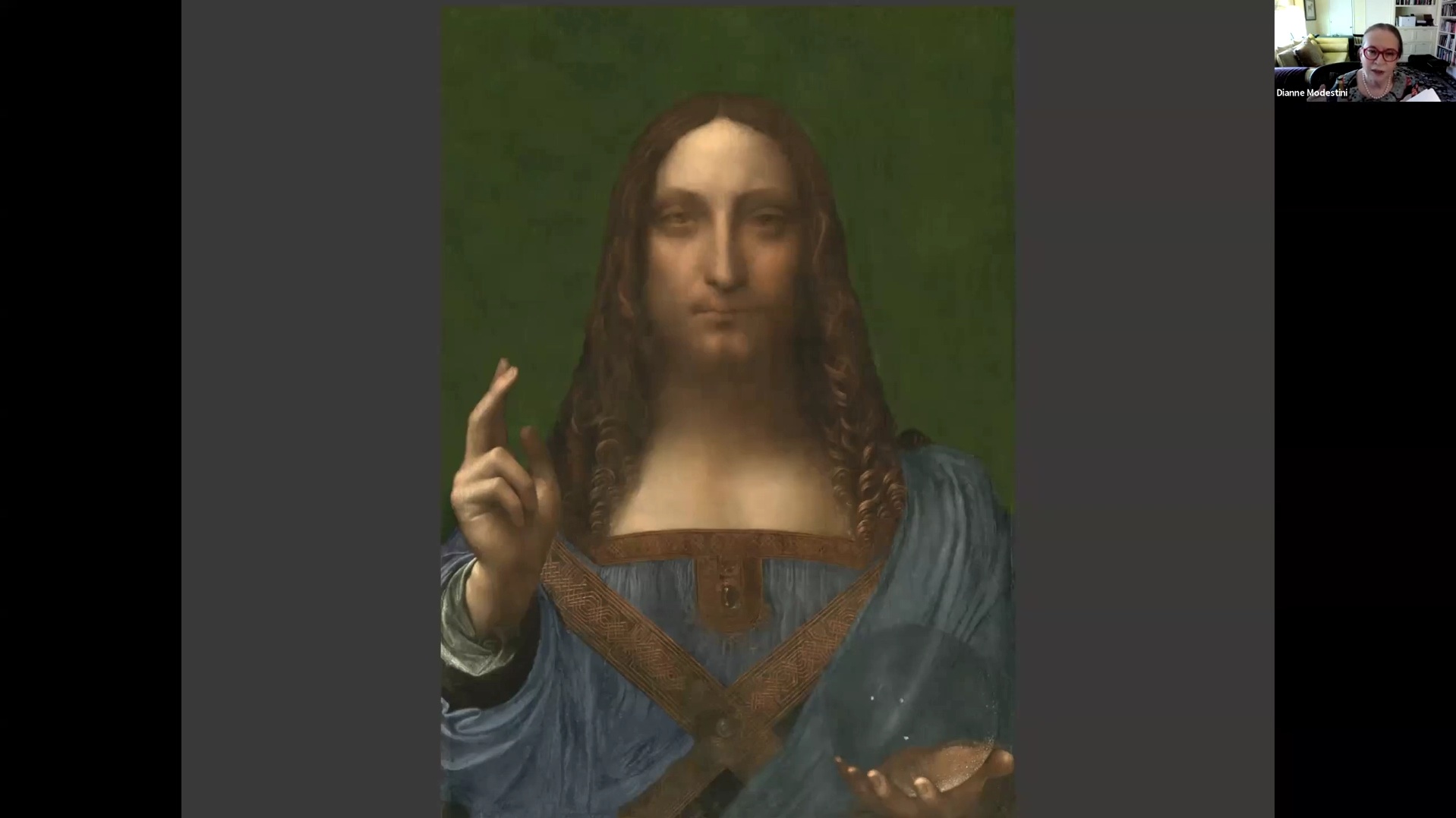
Five) Epilogue: A Background Muddy, Green or Black?
As you can see in the picture above a rather large area of the Salvator Mundi version Cook is actually background
(picture: youtube.com/Lowe Connect). It is not highlighted in green here to show how large a percentage of the picture
is actually background, but for a different reason: there are remnants of a background layer painted with the pigment of
verdigris in the picture as it actually is; and this means: there once was a layer of verdigris covering the background,
or in more simple words: the background of the picture, perhaps shocking for fans of sfumato, once was simply green (as
it is shown here).
The picture is taken from a recent online presentation with/by Dianne Modestini, the restorer of the painting. And after we have
looked at sparkling jewels and melting enamel, after we have seen an angry and frustrated French king (and an angry,
perhaps sarcastic, and probably also frustrated ambitious mother), we have now more than one reason to make us more
familiar with what is also a rather unknown area in the Salvator Mundi saga: it is not less spectacular as the
foreground, on the contrary: perhaps it is even more so. And this story begins with mud:
In the painting as it was handed over to Dianne Modestini, Christ had ›sunk into‹ a muddy background. This muddy layer
was removed, and what was found were these remnants of the green layer. Someone in the past must have tried to scrape it
off, but some parts had remained, also covering and in some way preserving what Dianne Modestini is interpreting as
Leonardo’s original background, which was black. On the basis of this interpretation she then re-established a black
background with several layers, painting the green layer away, which, in virtual representation is brought back in the
above picture.
What is remarkable here is one particular thing: Dianne Modestini is assuming that the green layer, an »early
embellishment«, was painted in France, since the use of verdigris pigment is consistent with the background of French
portraits of the era. And we find, a rare thing within the Salvator Mundi debate, a remarkable if small area of
consensus: this green background can be interpreted as a clue that the painting was in France, in, let’s say,
the 1520s. And my alternative hypothetical reconstruction of the picture’s biography differs here from the standard
narrative only as to one nuance: I would not be so sure that this green layer was painted against Leonardo’s
(or Melzi’s) wish. I could also imagine that the decision to apply a green layer on top of the black layer(s)
was the result of an interaction that could have involved several people: court artists, Italian (guest) artists etc.
etc. And how can we know if the green layer was applied only after Melzi had left France again?
What we do know is that Leonardo da Vinci seems not to have been a fan of verdigris, due to the pigment’s tendency to
fade if not being quickly varnished (for his view see here). But how do we know what exactly he, Melzi,
the king or the king’s mother had wanted?
And the decision to re-establish a black background raises the everlasting question again: how much did Leonardo,
how much did Melzi, how much did Franco-Flemish court artists, how much did a king, and how much did a king’s mother
contribute to the painting?
Not to mention early restorers, retouchers and later owners.
Brief: Given the history of the picture’s background – is it fair to say that Leonardo only ›contributed‹ to the background
(as it is now)?
At any rate: on the basis of the partial consensus that the painting might have been in France during the 16th century
we can now continue our metaphorical sailing around the island of Cuba: the 16th century saw the further chapters
of the Conquista; in Europe it saw the Age of the Reformation, and the ideas associated with Christ holding an orb
evolved. Which means: the ideas associated with Christ being the Saviour evolved; and the ideas of what an orb might be
representing evolved. The king’s sister, Marguerite of Navarre, author of the Heptaméron and perhaps another owner
of the painting (it might have passed to her from her mother’s hands), has one figure in her work say:
»‘So that, Ladies, is how the faith of the good Count remained firm against outward signs and miracles, for he knew
that we have but one Saviour, who, when He said Consummatum est, showed that he was leaving no way open for any
successor to bring us salvation.’«
The context changed. Apocalyptic moods, ›outward signs and miracles‹, and the question if the Pope
could still be interpreted as Christ’s successor were on the mind of the contemporaries, whoever exactly the owner
of the painting was. And this means: the picture, as something a beholder had to interpret, in some sense changed.
Because the frame of looking at it was in dramatic change. In the possession of Louise of Savoy it might have been
an unwanted reminder of a frustrating episode. In the possession of Marguerite of Navarre, looking at the Reformation
and being enganged in it, the painting might have begun to reflect new questions. One might go as far as saying that it
began to look back, if being looked at, in a wholly new way.
Annex: Synopsis of the reasons why a New Salvator Mundi History is plausible:
– the history of the cult of Charlemagne and the history of the Salvator Mundi iconography are interlinked;
specifically a Parisian depiction of Charlemagne holding an orb that can be interpreted as a representation of
rock crystal and that is placed at the heart of French politics has been identified; the cult of Charlemagne
points to French king Francis I with whom Leonardo was staying in the last years of his life and who was himself
being depicted as Charlemagne holding a globe by Raphael; the cult of Charlemagne, the idea of the Divine Right
of kings, and the visual representation of a ruler’s mandate and command over a reign are closely associated;
– it is not necessary to assign an early date to the Salvator Mundi version Cook; a cartoon, being the reference
for all the versions, has existed (traces of spolvero had been found in the version Cook very early); the version Ganay
with its global cruciger can be interpreted as being earlier as the version Cook; the thumb pentimento in the version
Cook can be interpreted as a correction that brought back the thumb where it had been meant to be;
– the hypothetical reconstruction is consistent with the findings of technical art history in the Louvre and
elsewhere (how is a painting from Leonardo’s workshop to look under the microscope if not like a picture from
Leonardo’s workshop?); the findings of the Louvre refer to a comparison with Leonardo’s last works; the Salvator Mundi
version Cook might have been one of the last works to which Leonardo contributed himself;
– the entirely blue garment of Christ can be associated with ›bleue de France‹ (this idea goes back to Frank Zöllner);
the verdigris layer in the background can be interpreted as verdigris ›de France‹ (see above)
– the placing of the genesis of the picture into the social space of Leonardo’s last years leaves us to work
with a limited number of possible contributors to the picture (Boltraffio had died in 1516; Leonardo was in France
with Melzi and Salaì); the various levels of technical accomplishment that can be observed in the picture
points to Melzi as the main author, being responsible for the solid and pedantic main work, with Leonardo contributing
the hyper-refined areas as the blessing hand and the orb inclusions, and with possibly Salaì being responsible at best
for the hastily completed folds;
– the social space of the court of Francis I was ideal for Leonardo being informed on the accomplishments of
Franco-Flemish artists; the court included an Italian-born humanist working on a history of the Franks, including a
chapter on Charlemagne;
– the appearance of Salvator Mundi paintings with artists of the second school of Fontainebleau points to a presence
of the painting at Fontainebleau; but Melzi, as Leonardo’s heir, might also have brought back the design to Italy where
further versions might have been produced (possibly sticking to the crystal ball instead of a globus cruciger);
– the not-only religious but also political bearing of the picture might be illustrated by a quote by Louise of Savoy,
the king’s mother, who can be regarded as an ideal recipient for the picture; if she indeed was the recipient we find
also a plausible explanation of the picture’s lacking of a major status, since it must shave been linked with the failed
campaign of Francis I in 1519 to become the emperor of the Holy Roman Empire;
– in sum this alternative model to what I am calling the standard model of Salvator Mundi thinking is fully consistent
with the findings of technical art history, with history and with stylistic observations in the painting itself; it
further offers the possibilities of exploring new hypotheses as to other versions, by examining more closely the social
space of the second school of Fontainebleau as well as the circle of Francesco Melzi, who, as the supposed main author,
has to be taken more seriously by maintstream Leonardo da Vinci scholarship.
Important literature:
Christine Tauber: Italianità am Hof von François Ier (1515-1521), in: Götz-Rüdiger Tewes / Michael Rohlmann (Eds.):
Der Medici-Papst Leo X. und Frankreich. Politik, Kultur und Familiengeschäfte in der europäischen Renaissance,
Tübingen 2002, p. 171-197;
Maike Priesterjahn: Charlemagne am Renaissancehof. Die Darstellung Karls des Grossen in Paolo Emilios De rebus gestis
Francorum, in: Patrick Baker / Ronny Kaiser / Maike Priesterjahn (Eds.): Portraying the Prince in the Renaissance:
The Humanist Depiction of Rulers in Historiographical and Biographical Texts, Berlin/Boston 2016, p. 39-64.
Karl-Ernst Geith: Karl der Grosse, in: Ulrich Müller / Werner Wunderlich (Eds.): Herrscher, Helden, Heilige,
St. Gallen 1996 (Mittelalter-Mythen; vol. 1), p. 87-100
1516: Paolo Emilio, Italian-born humanist at the court of Francis I, publishes the first four books of his history of the Franks; death of Boltraffio.
1517: Leonardo da Vinci, with Boltraffio and Salaì, has come to France (picture of Clos-Lucé: Manfred Heyde);
1517ff: Age of the Reformation; apocalyptic moods; Marguerite of Navarre, sister of Francis I, will be sympathizing with the reform movement in the following.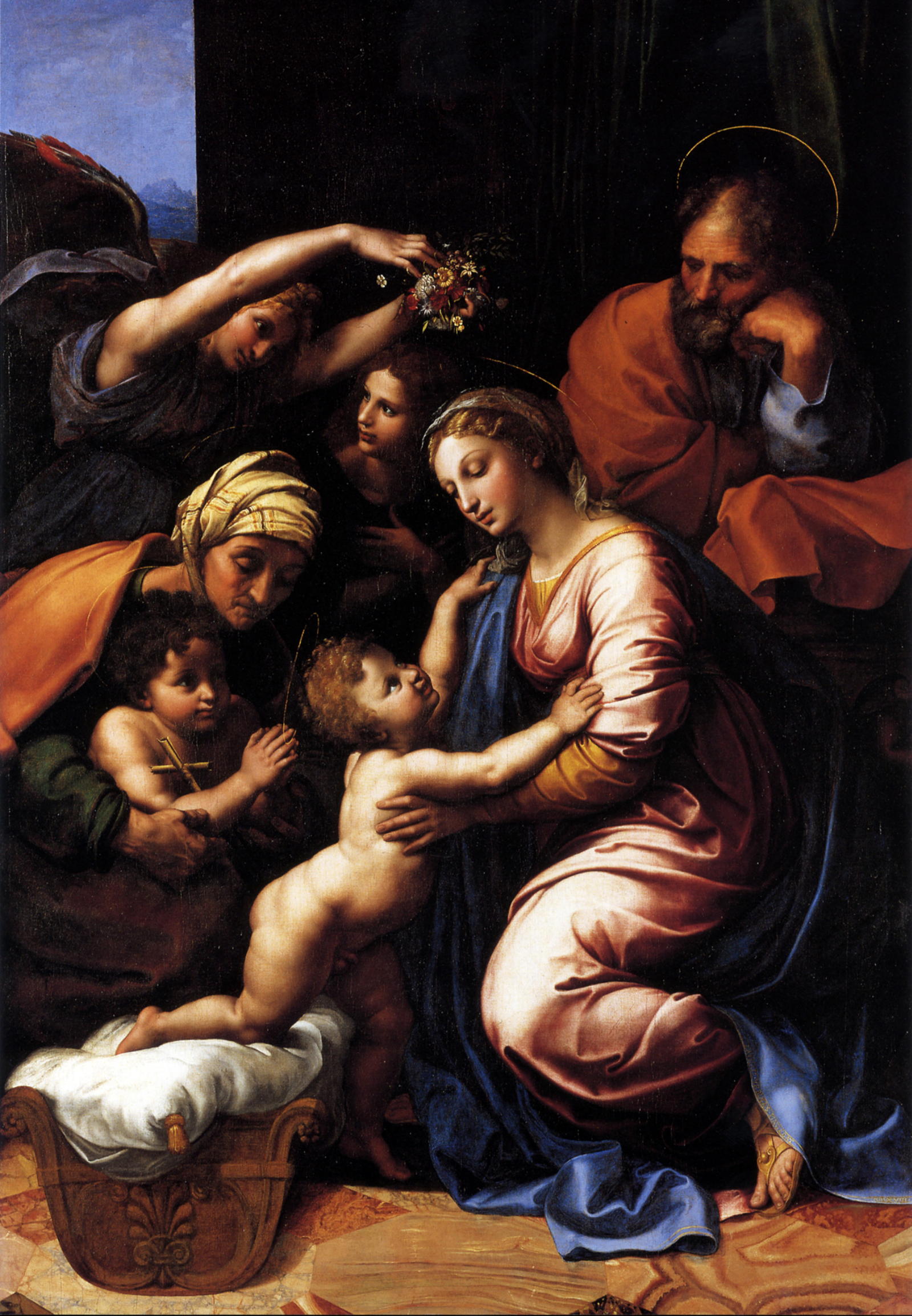
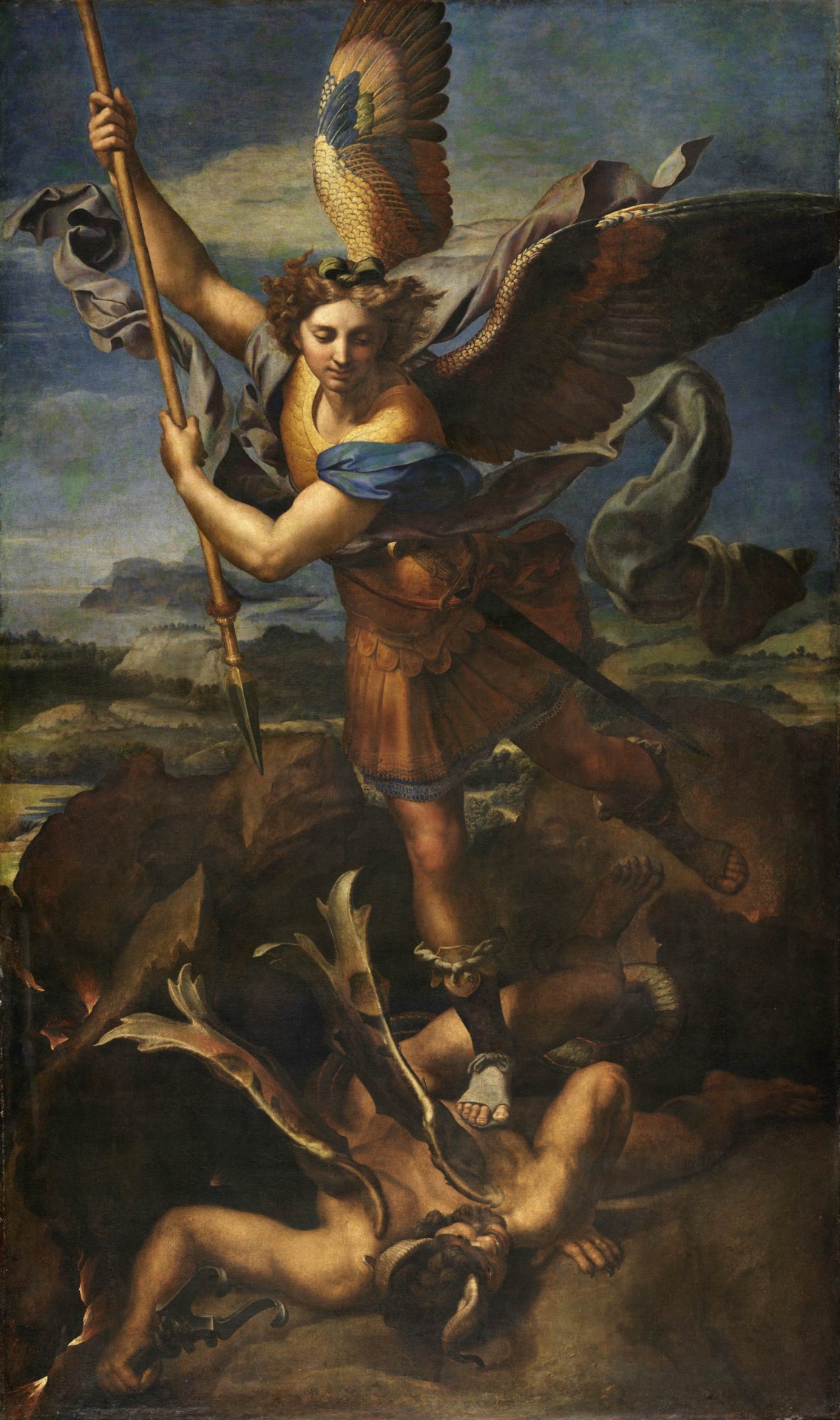
1518: the Raphael workshop produces/chooses paintings to be sent to France.
1519: death of emperor Maximilian I; Paolo Emilio publishes two further books of his history of the Franks; death of Leonardo da Vinci; Francis I is striving for the imperial crown, but in vain; Louise of Savoy comments upon the election of Charles, duke of Burgundy, who thus is becoming emperor Charles V (painting by Rubens).
1525: desaster of Francis I at Pavia.
1559: publication of the Heptaméron by Marguerite de Navarre
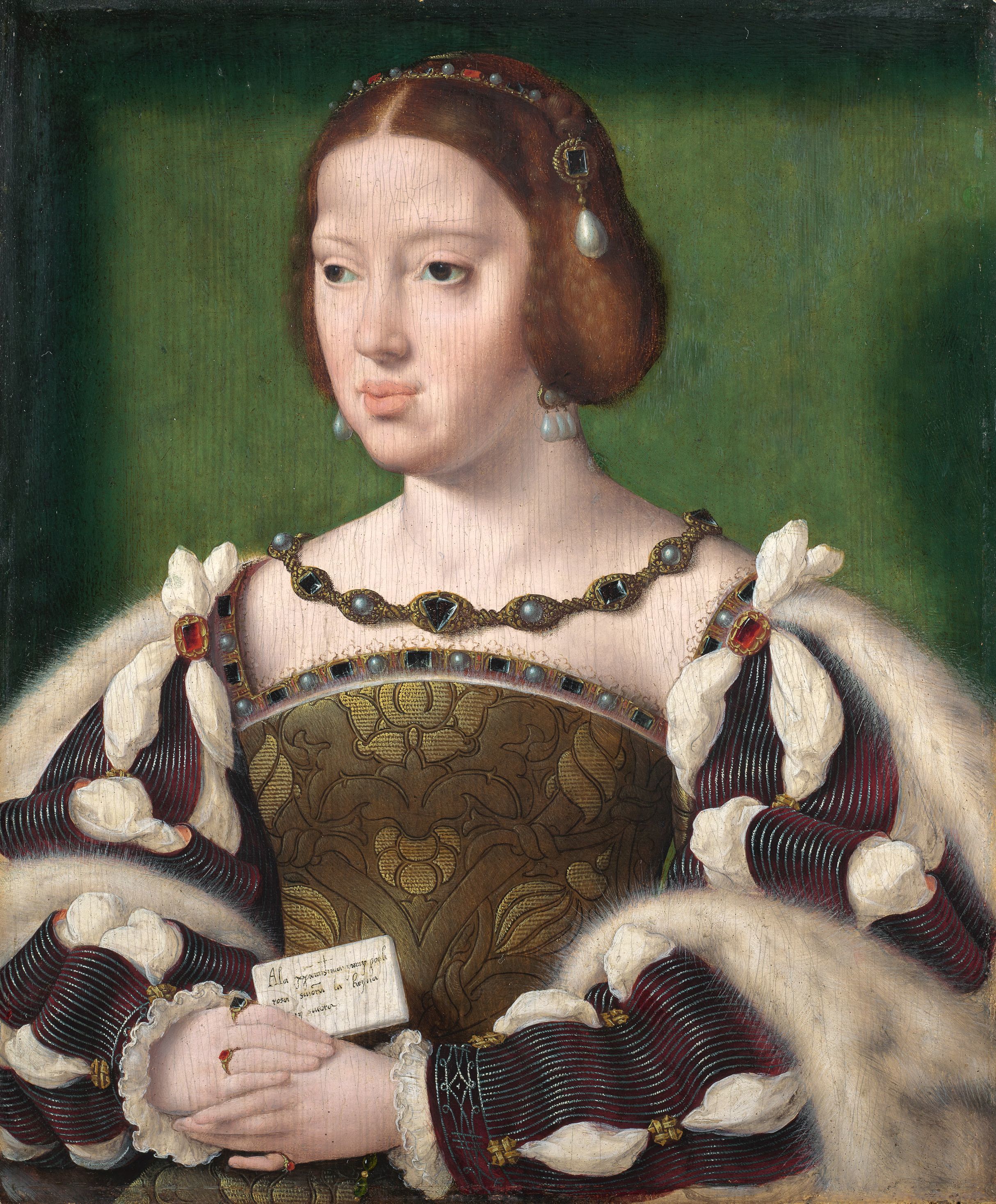
Here are two portraits with green background, one associated with the workshop of Joos van Cleve, the other with the workshop of Jean Clouet, both court painters of Francis I. We see Eleonore of France, second wife of Francis I, and one of her court ladies, Beatrix Pacheco.
See also:
Some Salvator Mundi Microstories
Some Salvator Mundi Afterthoughts
Some Salvator Mundi Variations
How To Tell Leonardo From Luini
MICROSTORY OF ART
ONLINE JOURNAL FOR ART, CONNOISSEURSHIP AND CULTURAL JOURNALISM
HOME
© DS